
Digitalis is a genus of about 20 species of herbaceous perennial plants, shrubs, and biennials, commonly called foxgloves.

Podocarpus is a genus of conifers, the most numerous and widely distributed of the podocarp family, the Podocarpaceae. The name comes from Greek πούς + καρπός. Podocarpus species are evergreen shrubs or trees, usually from 1 to 25 m tall, known to reach 40 m (130 ft) at times. The cones have two to five fused cone scales, which form a fleshy, berry-like, brightly coloured receptacle at maturity. The fleshy cones attract birds, which then eat the cones and disperse the seeds in their droppings. About 97 to 107 species are placed in the genus depending on the circumscription of the species.

Spartina is a genus of plants in the grass family, frequently found in coastal salt marshes. Species in this genus are commonly known as cordgrass or cord-grass, and are native to the coasts of the Atlantic Ocean in western and southern Europe, north-western and southern Africa, the Americas and the islands of the southern Atlantic Ocean; one or two species also occur on the western coast of North America and in freshwater habitats inland in the Americas. The highest species diversity is on the east coasts of North and South America, particularly Florida. They form large, often dense colonies, particularly on coastal salt marshes, and grow quickly. The species vary in size from 0.3–2 m tall. Many of the species will produce hybrids if they come into contact.
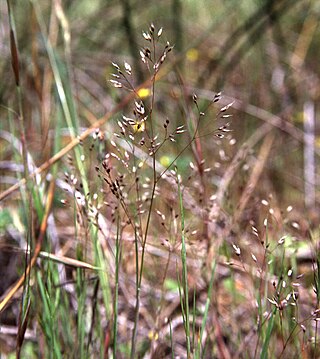
Aira is a genus of Old World plants in the grass family, native to western and southern Europe, central and southwest Asia, plus Africa.

Agropyron is a genus of Eurasian plants in the grass family), native to Europe and Asia but widely naturalized in North America.

Haworthia is a large genus of small succulent plants endemic to Southern Africa (Mozambique, Namibia, Lesotho, Eswatini and South Africa).
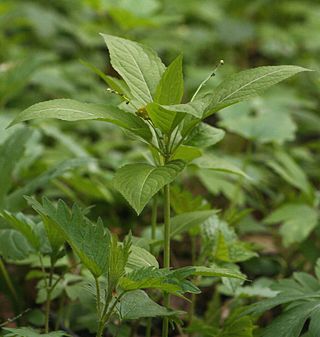
Mercurialis is a genus of plants in the family Euphorbiaceae, the spurges, known commonly as the mercuries. These are slender herbs (forbs), rhizomatious perennials and woody perennials, native to Europe, North Africa, and Asia.
- Mercurialis annuaL. – most of Europe, North Africa, the Middle East, and islands of the eastern Atlantic
- Mercurialis canariensisObbard & S.A.Harris – Canary Islands
- Mercurialis corsicaCoss. & Kralik – Corsica, Sardinia
- Mercurialis ellipticaLam. – Spain, Portugal, Morocco
- Mercurialis huetiiHanry – Spain, France, Morocco
- Mercurialis leiocarpaSiebold & Zucc. – China, Japan, Korea, Ryukyu Islands, Thailand, Assam, Bhutan, Nepal
- Mercurialis × longifoliaLam. – Spain, Portugal, France (M. annua × M. tomentosa)
- Mercurialis ovataSternb. & Hoppe – C + E Europe and SW Asia from Germany + Italy to Russia + Syria
- Mercurialis × paxiiGraebn. – C + E Europe from Germany to Crimea (M. ovata × M. perennis)
- Mercurialis perennisL. – most of Europe plus Algeria, Caucasus, Turkey, Iran
- Mercurialis reverchoniiRouy – Spain, Morocco
- Mercurialis tomentosaL. – Spain, Portugal, France, Balearic Islands
Yabeiceras is an extinct genus of cephalopods belonging to the ammonite family Collignoniceratidae. They flourished during the Coniacian age, and lived in South Africa.
Decorsea is a genus of legume in the family Fabaceae. It includes six species native to eastern and southern Africa, ranging from Tanzania to Namibia and South Africa, including Madagascar.
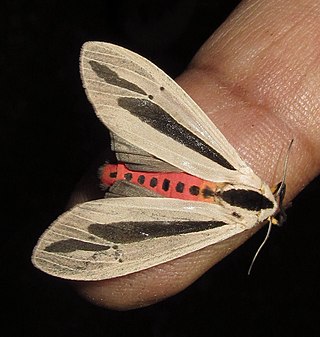
Creatonotos is a genus of tiger moths in the family Erebidae. The moths in the genus are found in the Afrotropics, South and East Asia, Sundaland and Australia.

Chloris is a widespread genus of monophyletic grasses belonging to the family Poaceae, known generally as windmill grass or finger grass. The genus is found worldwide, but especially in the tropical and subtropical regions, and more often in the Southern Hemisphere. The species are variable in morphology, but in general, the plants are less than 0.5 m in height. They bear inflorescences shaped like umbels, with several plumes lined with rows of spikelets. The genus is characterized by the series of sterile florets above the lowest fertile ones, spikes usually 4–10 in numbers, approximated or in a slightly separated series of 10–20 spikes, rarely an indefinite numbers of terminal spikes. In India, 11 species are known to occur in which only two are endemic viz. Chloris wightiana Nees ex Steud. and Chloris bournei Rangachariar & Tadulingam.
Leptocarydion is a genus of African and Arabic plants in the grass family.

Lagurus is a genus in the subfamily Arvicolinae. Lagurus includes a single living species, the steppe lemming of central Eurasia. The North American sagebrush vole has also been included in Lagurus, but is likely not closely related. The earliest fossils of Lagurus, allocated to Lagurus arankae, appear in the Late Pliocene. Two other fossil species, Lagurus pannonicus and Lagurus transiens, are thought to be part of a lineage that led to the living steppe lemming.
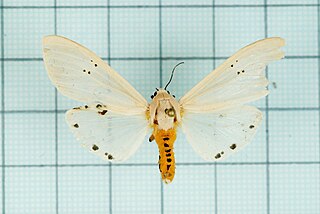
Creatonotos transiens is a species of moth in the family Erebidae. The species was first scientifically described by Francis Walker in 1855.
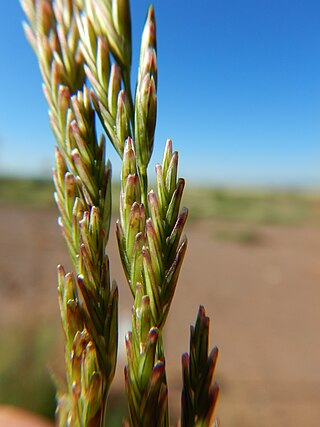
Disakisperma is a genus of plants in the grass family, native to North and South America, Africa, and the Arabian Peninsula.
Ellisochloa is a genus of Namibian and South African plants in the grass family.
Digitalis transiens is a species of flowering plant in the family Plantaginaceae which is endemic to Morocco. It was recently also classified as a synonym of D. subalpina. It has yellow flowers with woolly hairs on its lip and throat, the corolla length is 11 to 13mm.

Diplachne fusca, called bearded sprangletop, is a widespread species of grass in the genus Diplachne, native to North America, the Caribbean, South America, Africa, Asia, and Australia, and introduced in Europe, New Zealand and Hawaii, among other places. It prefers to live in salty, wet conditions, such as in salt marshes and shallow depressions.

Dais is a genus of flowering plants in the family Thymelaeaceae. It is also part of the Gnidia subfamily, along with Gnidia, Drapetes, Kelleria, Pimelea, Struthiola, Lachnaea and Passerina, other genera of species). It is distributed between Tanzania to S. Africa, Madagascar. It is native to the countries of Eswatini, Lesotho, Madagascar, Malawi, Tanzania, Zimbabwe and it is also found within several Provinces of South Africa, such as Cape Provinces, Free State, KwaZulu-Natal and Northern Provinces.
Vicia graminea is a species of flowering plant in the vetch genus Vicia, family Fabaceae. It is native to South America, where it has a meandering distribution in Colombia, Peru, Bolivia, Paraguay, northeast Argentina, southern Brazil, Uruguay, and southern Chile. It is the source for a lectin that is used to identify the N blood group antigen.













